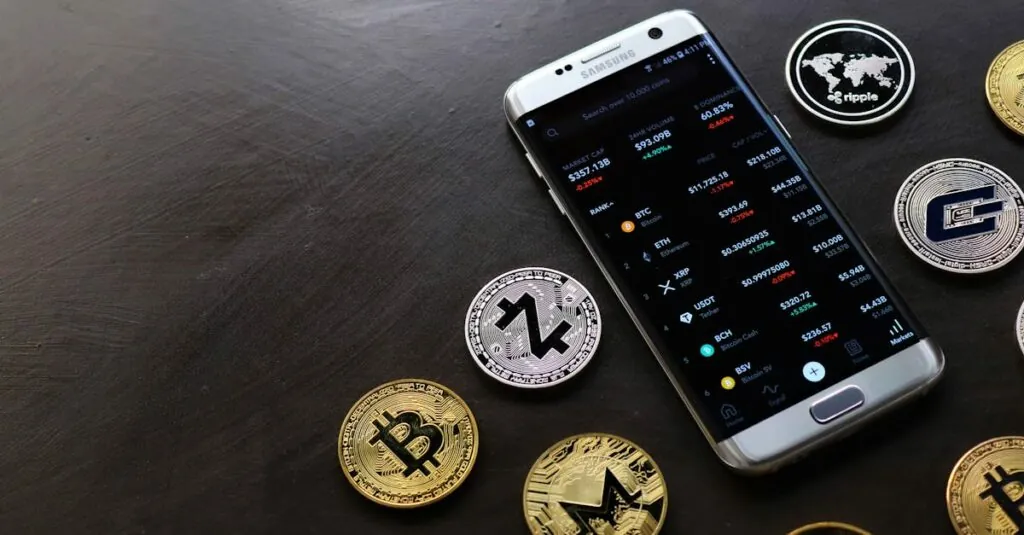Table of Contents
ToggleIn a world where instant gratification reigns supreme, waiting for a check to clear feels like waiting for a sloth to finish a marathon. Enter money transfer apps—the superheroes of the digital age. With just a few taps on a smartphone, anyone can send cash faster than you can say “broke college student.”
These apps have turned the tedious task of transferring money into a seamless experience, perfect for splitting dinner bills or sending that birthday gift you forgot. No more awkward cash exchanges or fumbling with change. They’re convenient, user-friendly, and often come with features that make managing finances a breeze. So, whether you’re sending money to a friend across town or a relative halfway around the globe, money transfer apps have got your back—and your wallet.
Overview of Money Transfer Apps
Money transfer apps offer a swift solution to traditional money transfer methods, enabling users to send funds efficiently. Users find these apps appealing due to their convenience and accessibility, whether transferring money within the same country or across borders. They support various payment methods, such as bank accounts and credit cards, enhancing flexibility for senders and receivers alike.
Security remains a top priority for these applications. Most apps employ encryption technologies and two-factor authentication to protect user information. This security measure builds trust, encouraging more individuals to opt for digital transactions over cash.
Cost-effectiveness also defines many money transfer apps. Certain apps charge minimal fees for sending money, especially for domestic transactions. Comparatively, international transfers may incur higher fees but often remain lower than traditional banking methods.
User experience plays a crucial role in the success of these apps. Intuitive interfaces allow users to navigate features effortlessly. Features such as transaction history, estimated delivery times, and customer support enhance user satisfaction.
Market leaders include apps like PayPal, Venmo, and Cash App. Each app meets different user needs, from casual transactions to business payments. A variety of new entrants constantly emerge, introducing innovative features to capture market share.
Adoption rates are on the rise. Younger demographics, in particular, favor using these apps for their reliance on mobile devices. As technology evolves, money transfer apps continue to adapt, ensuring their relevance in a changing financial landscape.
Key Features to Consider
When choosing a money transfer app, several key features significantly impact usability and security.
Security Measures
Security measures play an essential role in protecting user information during transactions. Most apps utilize encryption to safeguard data, ensuring privacy throughout the transfer process. Two-factor authentication adds an extra layer of protection, reducing unauthorized access risks. Users frequently prefer platforms that provide alerts for suspicious activities, which enhances security awareness. Regular updates to security protocols also reflect a commitment to maintaining user trust.
User Experience
User experience remains a defining factor in the success of money transfer apps. Intuitive interfaces simplify navigation, making transactions effortless for all users. Features such as transaction history enable easy tracking of past payments. Responsive customer support provides assistance quickly, addressing any issues that arise promptly. Personalization options enhance user satisfaction by tailoring the app according to individual preferences.
Fees and Limits
Fees and limits influence choices when selecting a money transfer app. Many apps charge minimal fees for domestic transfers, often under 3%. International fees frequently remain lower than traditional banking methods, providing a cost-effective solution for cross-border transactions. Users should consider transaction limits, as some apps impose caps on the amount that can be sent or received. Knowing these fees and limits helps users select an app that aligns with their financial needs.
Popular Money Transfer Apps Reviewed
This section reviews some popular money transfer apps, highlighting their key features and benefits that make them stand out.
App 1: Features and Benefits
PayPal remains a trusted name in money transfers. User-friendly interfaces make sending money a seamless task. Paid features include buyer protection for online transactions. Users enjoy the ability to send money internationally with minimal fees. PayPal also offers rapid withdrawal options, ensuring easy access to funds. Advanced security measures such as encryption safeguard users’ financial information.
App 2: Features and Benefits
Venmo is particularly popular among younger users for its social features. Users can easily share payment details on social media platforms, adding notes or emojis to transactions. The app allows instant bank transfers for a nominal fee. Venmo’s shared payment feature simplifies splitting bills among friends. Continuous updates ensure the app remains engaging while prioritizing user security through two-factor authentication.
App 3: Features and Benefits
Cash App offers unique features that appeal to a wide range of users. Users can invest in stocks or buy Bitcoin directly through the app. Instant transfers between Cash App users occur without fees, enhancing convenience. The app also includes a Cash Card, allowing users to spend their balance anywhere. Strong security protocols, including touch ID and facial recognition, protect user accounts.
Comparing Money Transfer Apps
PayPal excels in providing a user-friendly interface and strong security protocols, making international transfers seamless. Known for its buyer protection, it ensures users feel safe when conducting transactions online. Venmo offers a unique social aspect; users can share payment details, which adds a layer of interaction when splitting bills. High security measures protect users from potential fraud.
Cash App appeals to a diverse audience by providing unique features like stock investment options and Bitcoin purchases. Instant transfers come with no fees, enhancing its appeal for quick transactions. Security remains a priority with robust measures, including touch ID and facial recognition.
Cost structures vary among apps. PayPal charges minimal fees for domestic transfers, while Venmo is generally fee-free for friends and family transactions. Cash App typically has lower fees compared to traditional banking systems, particularly for international transfers. Users often select apps based on their specific financial needs and how fees align with their usage patterns.
Each app’s transaction limits can influence user decisions. PayPal allows higher limits for verified accounts, while Venmo has lower limits for unverified users. Cash App frequently updates its features to meet market demands and user expectations.
User engagement increases through personalized options available across platforms. Customization not only enhances user experience but also fosters brand loyalty. As technology advances, money transfer apps continue to adapt, ensuring they remain relevant in the dynamic financial sector.
Money transfer apps have revolutionized the way people handle financial transactions. Their convenience and user-friendly design make sending money a seamless experience. As these apps continue to evolve they adapt to user needs while prioritizing security and cost-effectiveness.
With a variety of options available users can choose the app that best fits their lifestyle and preferences. The growing popularity among younger generations highlights a shift toward digital solutions in financial management. As technology progresses these apps are likely to become even more integral to everyday transactions. Embracing these innovations can lead to a more efficient and secure way of managing money.







